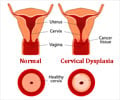Women with invasive cervical cancer are more likely to have an incidence of iatrogenic injuries and non-iatrogenic injuries requiring hospitalization than women with a normal smear.

‘Women with invasive cervical cancer often experience medical complications and psychological stress during their diagnostic workup.
’
Read More..




Previous work conducted by Shen and colleagues demonstrated an increased risk of injuries during the time period before and after a cancer diagnosis. "These injuries were likely a result of invasive procedures and the severe psychological distress experienced during the clinical evaluation of potential cancer," Shen explained. Whether there is a similar increase in risk among patients screened for cervical cancer when an organized cancer screening program was largely accessible was unknown, she added. Read More..
Using data from the Swedish Total Population Register, the researchers identified over 3 million women who participated in cervical cancer screening during 2001-2012. Cross-linkage with multiple Swedish registries allowed for the identification of women within this cohort who received a diagnosis of invasive cervical cancer, cervical cancer precursor lesions, or had a normal smear during follow-up. The final cohort included roughly 1.85 million women with a normal smear, roughly 22,000 women with cervical intraepithelial neoplasia (CIN) grade 1, roughly 21,000 women with CIN2, and roughly 37,000 CIN3/adenocarcinoma in situ (AIS), and roughly 5,000 women with invasive cervical cancer.
The researchers examined the incidence of injuries during the diagnostic workup of patients who participated in cervical cancer screening. Among women with precursor lesions or cervical cancer, the diagnostic workup was defined as the time interval between the first Pap smear or punch biopsy until surgical treatment, or two months after the last smear or punch biopsy, if not treated surgically. The diagnostic workup was defined among women with normal smear results as the two months following the smear.
The researchers calculated incidence rates of both iatrogenic injuries and non-iatrogenic injuries that occurred during the diagnostic workup. Iatrogenic injuries, which were mostly related to receipt of a punch biopsy and required at least two days of hospitalization, were included in this analysis. Non-iatrogenic injuries, which included accidents and intentional self-harm, required at least one day of hospitalization, were included.
Incidence rate ratios for injuries that occurred during the diagnostic workup, which were calculated by comparing women with a diagnosis of cervical cancer or its precursor lesions with women with a normal smear, were adjusted for age, calendar period, screening adherence, education, income, and marital status.
Advertisement
"Women with invasive cancer can have greater vascularity due to tumor growth, which can lead to hemorrhage and hematoma following a biopsy," Shen explained. Common iatrogenic injuries in this study included hemorrhage, hematoma, and infection.
Advertisement
"An increase in non-iatrogenic injuries points to high levels of psychological distress in relation to receiving a diagnosis of cervical cancer," said Shen. "Women with cervical cancer can be criticized about their sexual behaviors, leading to a social stigma that could contribute to this stress," she added.
"This study, for the first time, systematically examined the risks of injuries during the cervical diagnostic workup. Although the chance of having such injuries was rare, we found an increased risk of inpatient care for iatrogenic and non-iatrogenic injuries for women with invasive cervical cancer. However, it is important to emphasize that cervical cancer screening is greatly beneficial for the early detection of cancer and is largely safe."
The study's limitations include a lack of information on non-surgical treatments among women with invasive cervical cancer, such as palliative care, chemotherapy, and radiotherapy, which could have potential implications for injuries. Further, because the authors only included iatrogenic injuries that required at least two days of inpatient care, only the most severe form of these injuries was captured in this analysis.
Source-Eurekalert















